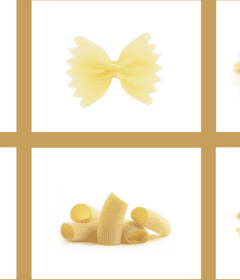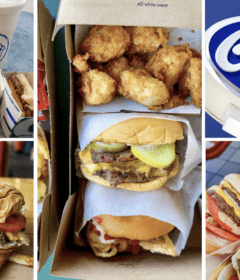Classic Holiday Dinner Recipes
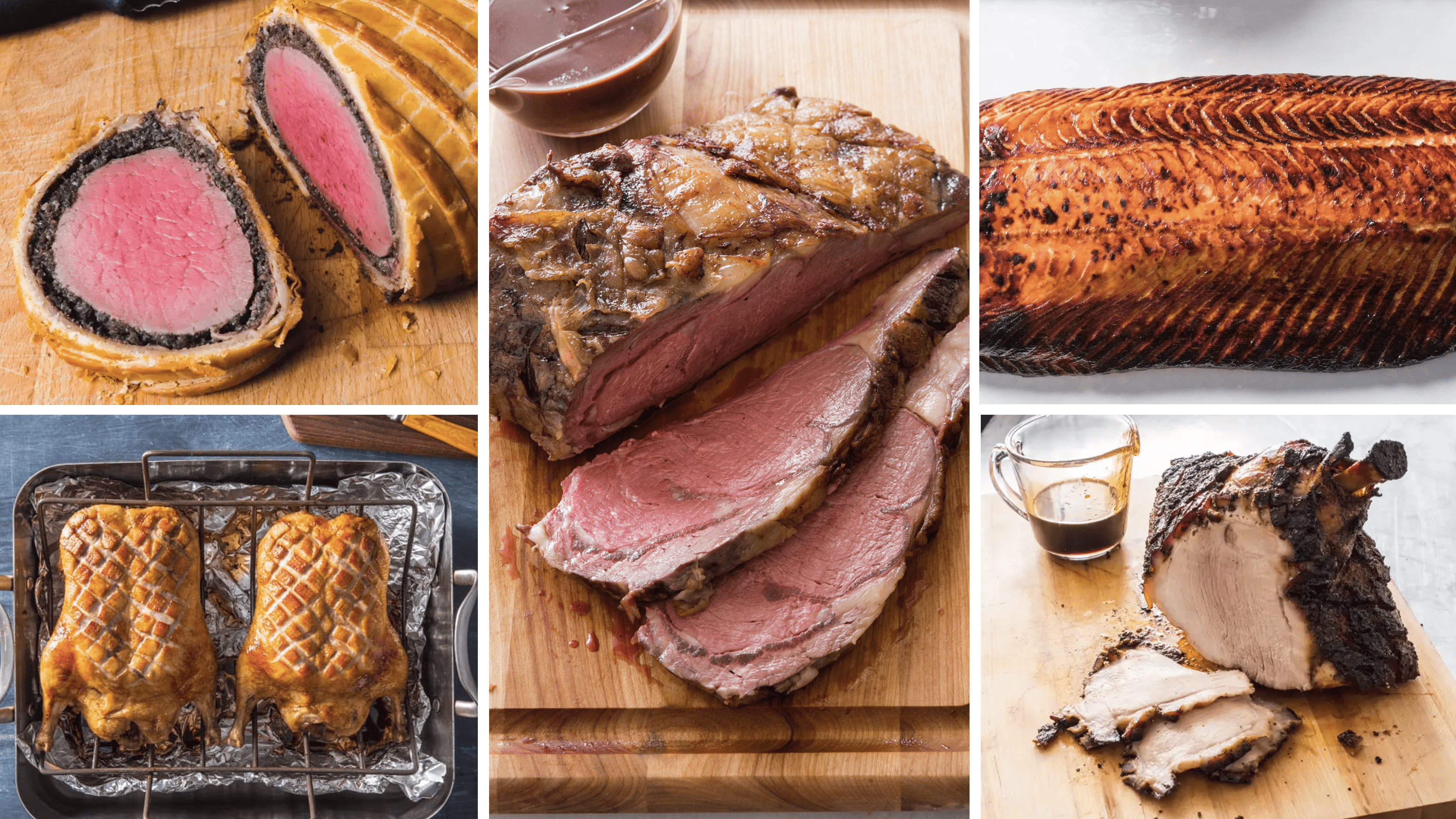
Classic Holiday Dinner Recipes – Ideas for your Holiday Dinner.
Classic Holiday Dinner Recipes range from juicy prime rib to Whole Roast Ducks with Cherry Sauce.
Classic Holiday Dinner Recipes – Have you ever wondered if your family’s go-to recipes are popular in kitchens across America?
Classic Holiday Dinner Recipes – A YouGov poll asked 1,140 people to choose the better of two Christmas foods in a series of head-to-head matchups.
Classic Holiday Dinner Recipes – The holiday dish that won the most matchups might surprise you – It wasn’t turkey—or even ham.
The Most Popular Christmas Dishes
Classic Holiday Dinner Recipes – The #1 pick is roast potatoes, with a win percentage of 76%. Mashed potatoes came in second (75%), and turkey was third (73%)—the only protein in the top five.
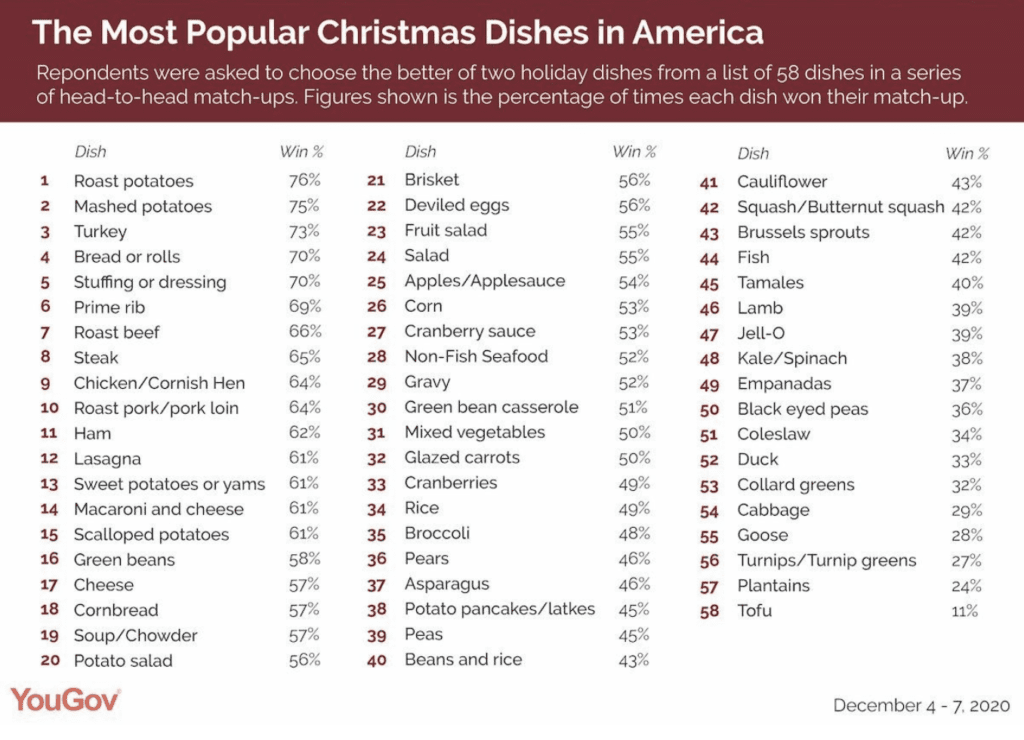
Classic Holiday Dinner Recipes – Best Prime Rib
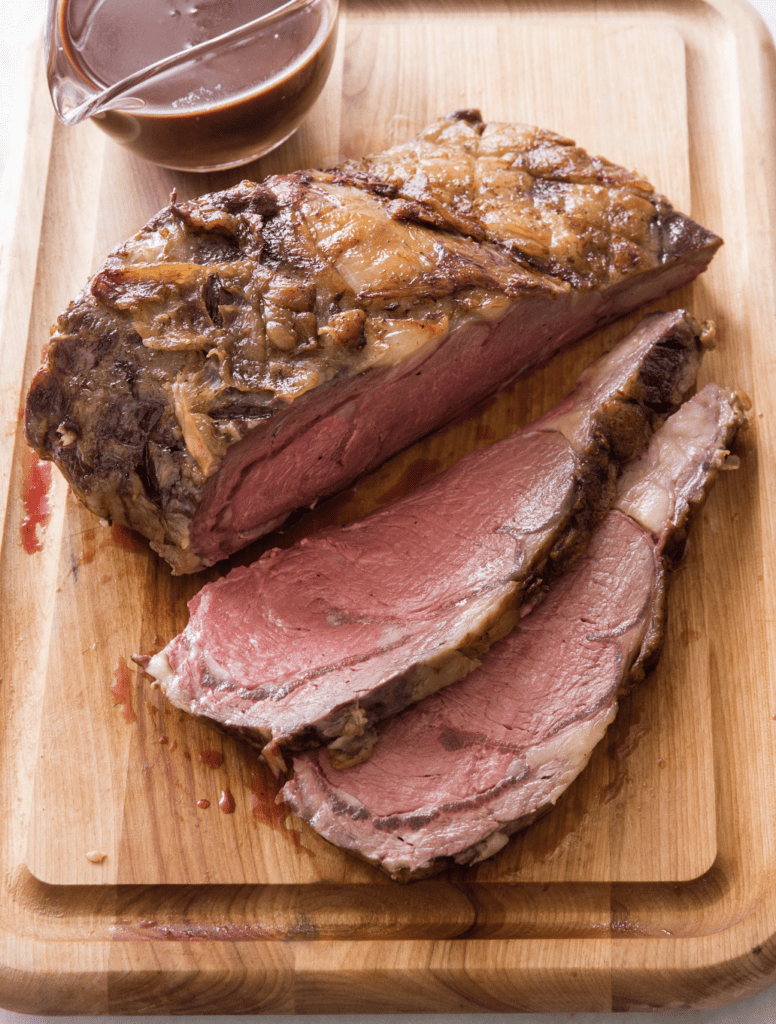
Best Prime Rib Overview
The perfect prime rib should have a deep-colored, substantial crust encasing a tender, juicy rosy-pink center.
To achieve this perfect roast, start by salting the roast overnight.
The salt enhanced the beefy flavor while dissolving some of the proteins, yielding a buttery-tender roast.
To further enhance tenderness, cook the roast at a very low temperature, which allowed the meat’s enzymes to act as natural tenderizers, breaking down its tough connective tissue.
A brief stint under the broiler before serving ensured a crisp, flavorful crust.
Best Prime Rib Recipe
Using sharp knife, cut slits in surface layer of fat, spaced 1 inch apart, in crosshatch pattern, being careful to cut down to, but not into, meat.
Rub 2 tablespoons salt over entire roast and into slits.
Place meat back on bones (to save space in refrigerator), transfer to large plate, and refrigerate, uncovered, at least 24 hours and up to 96 hours.
Adjust oven rack to middle position and heat oven to 200 degrees.
Heat oil in 12-inch skillet over high heat until just smoking.
Sear sides and top of roast (reserving bone) until browned, 6 to 8 minutes total (do not sear side where roast was cut from bone).
Place meat back on ribs, so bones fit where they were cut, and let cool for 10 minutes; tie meat to bones with 2 lengths of twine between ribs.
Transfer roast, fat side up, to wire rack set in rimmed baking sheet and season with pepper.
Roast until meat registers 110 degrees, 3 to 4 hours.
Turn off oven; leave roast in oven, opening door as little as possible, until meat registers about 120 degrees for rare or about 125 degrees for medium-rare, 30 to 75 minutes longer.
Remove roast from oven (leave roast on baking sheet), tent loosely with aluminum foil, and let rest for at least 30 minutes and up to 75 minutes.5
Adjust oven rack about 8 inches from broiler element and heat broiler.
Remove foil from roast, form into 3-inch ball, and place under ribs to elevate fat cap.
Broil until top of roast is well browned and crisp, 2 to 8 minutes.6
Transfer roast to carving board; cut twine and remove roast from ribs.
Slice meat into 3/4-inch-thick slices.
Season with coarse salt to taste, and serve.
Best Prime Rib Ingredients
1 (7-pound) first-cut beef standing rib roast (3 bones), meat removed from bones, bones reserved
Kosher salt and ground black pepper
2 teaspoons vegetable oil
Classic Holiday Dinner Recipes – Roasted Whole Side of Salmon
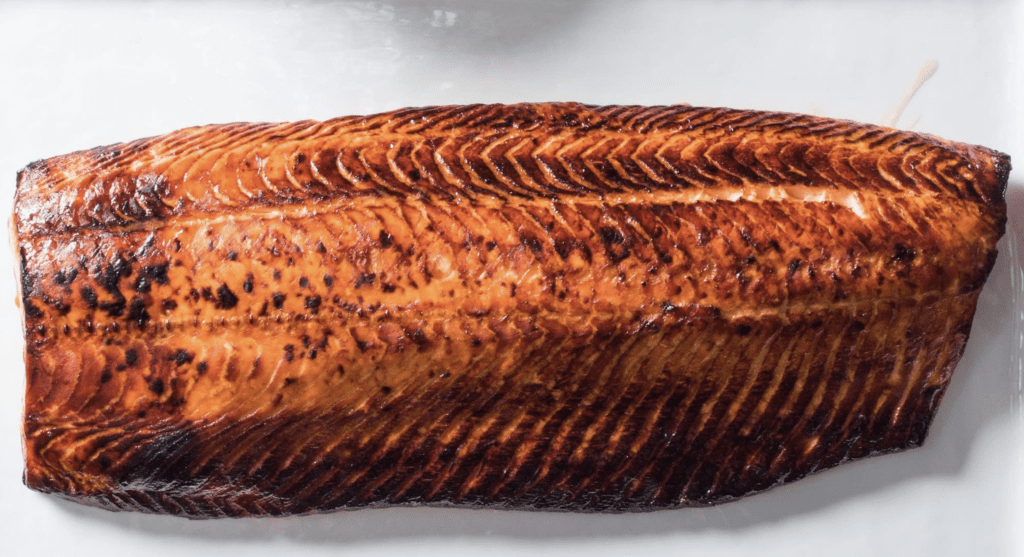
Roasted Whole Side of Salmon
To roast a side of salmon that was silky throughout and evenly browned across its surface, salt it for an hour, which helps the flesh retain moisture and protein (which would otherwise seep out unattractively during roasting).
Placing it on a greased aluminum foil sling ensured that it was easy to transfer to a serving platter.
For cooking, set the salmon on a wire rack set in a rimmed baking sheet to encourage air circulation around the fillet.
Evenly brushing the salmon’s surface with honey encouraged rapid browning.
Use a three-step cooking process for the best results.
First, preheated the oven to 250 degrees to warm the entire oven, which ensured that cooking happened quickly and evenly.
Second, broil the fillet until it just began to brown.
Third, turn the oven heat to 250 degrees to allow the fillet to gently cook through
Roasted Whole Side of Salmon Recipe
This recipe requires salting the fish for at least 1 hour.
Look for a fillet that is uniformly thick from end to end.
The surface will continue to brown after the oven temperature is reduced.
If the surface starts to darken too much before the fillet’s center registers 125 degrees, shield the dark portion with aluminum foil.
If using wild salmon, which contains less fat than farmed salmon, remove it from the oven when the center of the fillet registers 120 degrees.
Sprinkle flesh side of salmon evenly with 1 tablespoon salt and refrigerate, uncovered, for at least 1 hour or up to 4 hours.
Adjust oven rack 7 inches from broiler element and heat oven to 250 degrees.
Line rimmed baking sheet with aluminum foil and place wire rack in sheet.
Fold 18 by 12-inch piece of foil lengthwise to create 18 by 6-inch sling.
Place sling on wire rack and spray with vegetable oil spray.3
Heat broiler.
Pat salmon dry with paper towels and place, skin side down, on foil sling.
Brush salmon evenly with honey and broil until surface is lightly but evenly browned, 8 to 12 minutes, rotating sheet halfway through broiling.4
Return oven temperature to 250 degrees and continue to cook until center of fillet registers 125 degrees, 10 to 15 minutes longer, rotating sheet halfway through cooking.
Using foil sling, transfer salmon to serving platter, then carefully remove foil. Serve, passing lemon wedges separately.
Roasted Whole Side of Salmon Ingredients
1 (4-pound) skin-on side of salmon, pinbones removed and belly fat trimmed
Kosher salt
2 tablespoons honey
Lemon wedges
Classic Holiday Dinner Recipes – Whole Roast Ducks with Cherry Sauce
The qualities that make duck special to eat—it contains all dark meat that’s rich in flavorful fat—also make it a challenge to cook well.
Trim the birds thoroughly of excess fat around the neck and cavity, and then scored the skin extensively to create channels for rendered fat to escape.
Salt the ducks for at least 6 hours to help keep them juicy and thoroughly seasoned the rich meat, highlighting its full flavor.
Used a two-part cooking method: Give the tougher legs a head start by submerging the bottom half of the ducks in water in a roasting pan and vigorously simmering them on the stove until the leg quarters registered 145 to 160 degrees.
Meanwhile, because the breasts will not have contact with the water, they cooked more slowly.
Then, move the birds to a V-rack and finished them in the oven, glazing them first with a soy sauce—maple syrup glaze to encourage deep browning.
A bright, fruity cherry sauce made for a vibrant accompaniment that balanced the rich meat.
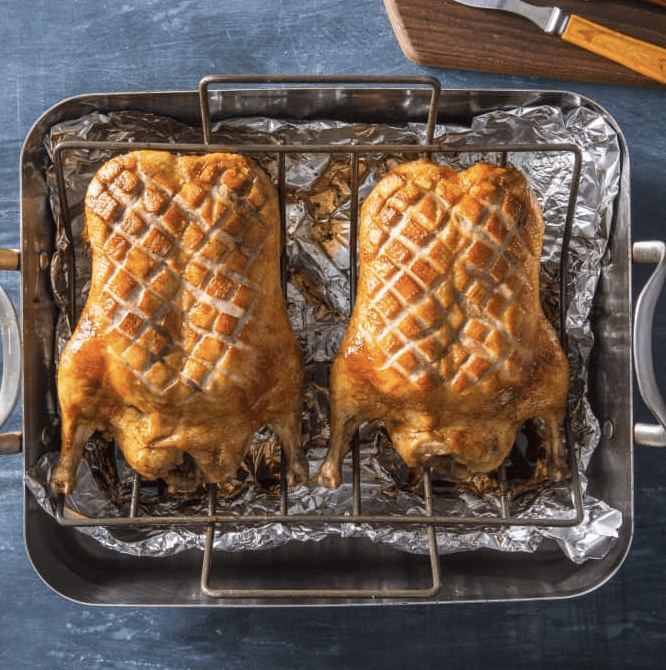
Whole Roast Ducks with Cherry Sauce Recipe
FOR THE DUCKS
Working with 1 duck at a time, use your hands to remove large fat deposits from bottom of cavity.
Using kitchen shears, trim excess neck skin from top of breast; remove tail and first 2 segments from each wing, leaving only drumette.
Arrange duck breast side up.
With tip of sharp knife, cut slits spaced ¾ inch apart in crosshatch pattern in skin and fat of breast, being careful not to cut into meat.
Flip duck breast side down.
Cut parallel slits spaced ¾ inch apart in skin and fat of each thigh (do not crosshatch)
Rub 2 teaspoons salt into cavity of 1 duck.
Rub 1 teaspoon salt into breast, taking care to rub salt into slits.
Rub 1 tablespoon salt into skin of rest of duck. Align skin at bottom of cavity so 1 side overlaps other by at least ½ inch.
Use sturdy toothpick to pin skin layers to each other to close cavity. Place duck on rimmed baking sheet.
Repeat with second duck. Refrigerate uncovered for 6 to 24 hours.
Place ducks breast side up in roasting pan.
Add water until at least half of thighs are submerged but most of breasts remain above water, about 14 cups.
Bring to boil over high heat.
Reduce heat to maintain vigorous simmer.
Cook until thermometer inserted into thickest part of drumstick, all the way to bone, registers 145 to 160 degrees, 45 minutes to 1 hour 5 minutes.
After 20 minutes of cooking, adjust oven rack to lower-middle position and heat oven to 425 degrees. Stir maple syrup and soy sauce together in bowl.
Set V-rack on rimmed baking sheet and spray with vegetable oil spray.
Remove roasting pan from heat.
Using tongs and spatula, lift ducks from pan one at a time, allow liquid to drain, and transfer to V-rack, breast side up.
Brush breasts and tops of drumsticks with approximately one-third of maple syrup mixture. Flip ducks and brush remaining mixture over backs and sides.
Transfer braising liquid to pot or large bowl to cool. (Once cool, defat liquid and reserve liquid and/or fat for another use, if desired.)
Rinse roasting pan and wipe with wad of paper towels. Crumple 20-inch length of aluminum foil into loose ball.
Uncrumple foil and place in roasting pan.
Set V-rack on foil.
Roast until backs are golden brown and breasts register 140 to 150 degrees, about 20 minutes.5
Remove roasting pan from oven.
Using tongs and spatula, flip ducks breast side up.
Continue to roast until breasts register 160 to 165 degrees, 15 to 25 minutes longer.
Transfer ducks to carving board and let rest for 20 minutes.
FOR THE CHERRY SAUCE
Whisk maple syrup, vinegar, soy sauce, cornstarch, and pepper together in small saucepan.
Add thyme sprigs and bring to simmer over medium-high heat, stirring constantly with rubber spatula.
Continue to cook, stirring constantly, until mixture thickens, 2 to 3 minutes longer.
Stir in cherries and cook, stirring occasionally, until sauce has consistency of maple syrup, 5 to 8 minutes.
Discard thyme sprigs and season with salt and pepper to taste.
Transfer to serving bowl. Carve duck and serve, passing sauce separately.
Whole Roast Ducks with Cherry Sauce Recipe Ingredients
Ducks
2 (5½- to 6-pound) Pekin ducks, necks and giblets reserved if making stock
¼ cup kosher salt, divided
2 tablespoons maple syrup
1 tablespoon soy sauce
Cherry Sauce
⅓ cup maple syrup
¼ cup red wine vinegar
4 teaspoons soy sauce
2 teaspoons cornstarch
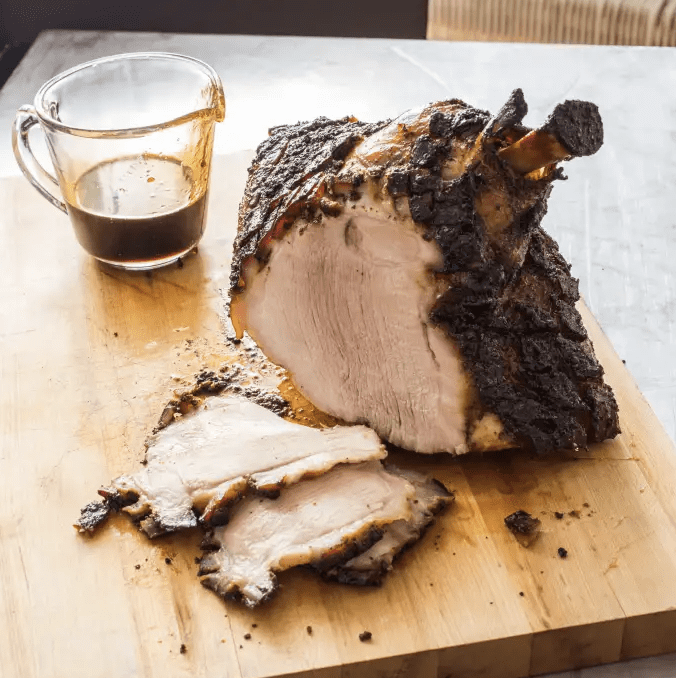
Roast Fresh Ham Recipe
For a flavorful, succulent fresh ham recipe worthy of a holiday table, purchase a shank end with the skin on and scored the fat.
Then we brined the ham in a solution flavored with brown sugar, garlic, bay leaves, and black peppercorns.
Starting the ham at high heat and finishing at low heat yields a crisp, flavorful skin and tender meat.
Finished our fresh ham recipe with a sweet—but not too sweet—glaze.
If you don’t have room in your refrigerator, you can brine the ham in a large insulated cooler or a small plastic garbage can; add five or six freezer packs to the brine to keep it well cooled.
Carefully slice through skin and fat with serrated knife, making 1-inch diamond pattern. Be careful not to cut into meat.2
In large (about 16-quart) bucket or stockpot, dissolve salt and brown sugar in 1 gallon hot tap water.
Add garlic, bay leaves, black pepper, and 1 gallon cold water. Submerge ham in brine and refrigerate 8 to 24 hours.
Set large disposable roasting pan on baking sheet for extra support; place flat wire rack in roasting pan.
Remove ham from brine; rinse under cold water and dry thoroughly with paper towels.
Place ham, wide cut-side down, on rack. (If using sirloin end, place ham skin-side up.)
Let ham stand, uncovered, at room temperature 1 hour.4
Meanwhile, adjust oven rack to lowest position and heat oven to 500 degrees.
In work bowl of food processor fitted with steel blade, process sage, parsley, garlic, salt, pepper, and oil until mixture forms smooth paste, about 30 seconds. Rub all sides of ham with paste.5
Roast ham at 500 degrees for 20 minutes.
Reduce oven temperature to 350 degrees and continue to roast, brushing ham with glaze every 45 minutes, until center of ham registers 145 to 150 degrees on instant-read thermometer, about 2 1/2 hours longer.
Tent ham loosely with foil and let stand until center of ham registers 155 to 160 degrees on thermometer, 30 to 40 minutes.
Carve, following instructions below, and serve.
Roast Fresh Ham Recipe Ingredients
Roast
6 – 8 pound ham bone-in with skin, preferably shank end, rinsed
Brine
4 cups kosher salt or 2 cups table salt, for brining
3 cups brown sugar packed (dark or light), for brining
2 heads garlic, cloves separated, lightly crushed and peeled
10 bay leaves
½ cup whole black peppercorns, crushed
Garlic and Herb Rub
1 cup fresh sage leaves, packed lightly
½ cup fresh parsley leaves
8 medium cloves garlic, peeled
1 tablespoon kosher salt or 1 1/2 teaspoons table salt
½ tablespoon ground black pepper
¼ cup olive oil
Glaze
1 Apple Cider and Brown Sugar Glaze
Classic Holiday Dinner Recipes – Classic Beef Wellington
This Beef Wellington recipe is packed with flavor.
Simple salt the beef tenderloin overnight and then slathered it with piquant Dijon mustard before wrapping it in umami-rich prosciutto spread with super-concentrated duxelles.
Instead of traditional puff pastry for sturdier, easier-to-work-with pâte brisée, which produces a firm yet flaky and tender crust that slices neatly when served.
To producing a perfectly baked crust and uniformly medium-rare beef, roast the Wellington in a 450-degree oven and removed it when the beef registered a mere 85 degrees.
Carryover cooking did the rest of the work, as the meat’s temperature gradually rose to 130 degrees (medium-rare).
Create a Creamy Green Peppercorn Sauce and a Madeira Sauce, provides two options for finishing the decadent dish.
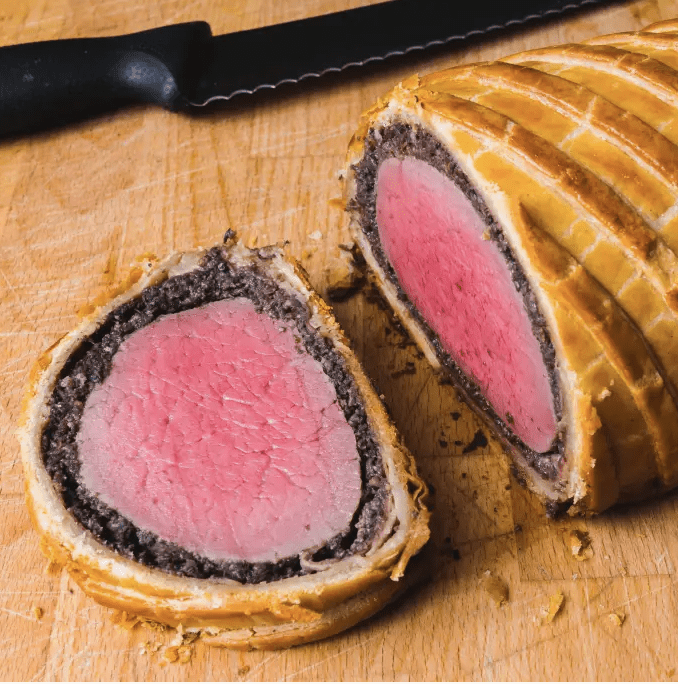
Classic Beef Wellington Recipe
FOR THE BEEF
Sprinkle all sides of beef evenly with salt. Wrap in plastic wrap and refrigerate for at least 12 hours or up to 3 days.
FOR THE PASTRY
Using stand mixer fitted with paddle, mix flour, butter, and salt on medium-low speed until mixture is crumbly and pieces of butter are no larger than peas, 4 to 5 minutes. With mixer running, add ice water in steady stream. Increase speed to medium and continue to mix until smooth dough comes together around paddle, 1 to 3 minutes longer. Transfer dough to lightly floured counter. Remove one-quarter (about 4 ounces) of dough; shape into 3-inch square. Shape remaining dough into 6-inch square. Wrap both pieces in plastic and refrigerate for at least 8 hours or up to 2 days.
FOR THE DUXELLES
Process shallots and garlic in food processor until very finely chopped, about 30 seconds, scraping down sides of bowl as needed. Transfer to small bowl. Pulse mushrooms until mushrooms resemble couscous, about 10 pulses, scraping down sides of bowl halfway through processing (do not over-process).
Melt butter in 12-inch nonstick skillet over medium-low heat. Add shallot mixture and cook, stirring frequently, until softened, 3 to 5 minutes. Stir in mushrooms, pepper, and salt and cook, stirring occasionally, until liquid given off by mushrooms has evaporated and mushrooms begin to sizzle, 25 to 30 minutes. Add Madeira to mushroom mixture and cook, stirring constantly, until evaporated, about 1 minute. Off heat, stir in thyme. (If making duxelles ahead, let cool completely and refrigerate in airtight container for up to 3 days.)
TO ASSEMBLE
Overlap 2 pieces of plastic on counter to form 20 by 20-inch square (it’s OK if up to 2 inches of plastic hangs off edge of counter). Shingle prosciutto in center of plastic in 2 slightly overlapping rows to form 14 by 9-inch rectangle, with shorter side parallel to edge of counter. Transfer duxelles to prosciutto and use offset spatula to spread in even layer, leaving 1-inch border of prosciutto on all sides (if duxelles is cold, microwave for 1 minute to soften before spreading).
Unwrap beef and pat dry with paper towels. Brush all sides of beef with mustard and sprinkle with pepper. Arrange roast parallel to edge of counter, about one-third of way up duxelles. Using both hands, lift bottom edge of plastic to begin wrapping roast. Continue to roll roast, leaving plastic behind, until roast is completely wrapped in prosciutto. Tuck overhanging slices of prosciutto over each end of roast. Tightly roll roast in plastic and twist plastic tightly at each end to seal. Continue to twist ends of plastic and roll roast on counter until formed into snug cylinder. Refrigerate for at least 30 minutes or up to 2 days before cooking.
Line 2 rimmed baking sheets with parchment paper. Roll out larger piece of dough on generously floured counter into 14 by 12-inch rectangle. Drape dough over rolling pin, transfer to prepared sheet, and refrigerate. Roll smaller piece of dough into 12 by 5-inch rectangle. Transfer to second prepared sheet and refrigerate.8
Whisk together egg and yolk. Lay large pastry sheet directly on counter with short sides parallel to edge of counter. Brush entire surface with egg wash; set aside remaining egg wash. Unwrap beef and place on pastry, arranging it parallel to edge of counter and 2 inches from pastry edge closest to you. Wrap edge of pastry closest to you over beef. Holding edge in place, slowly roll roast away from you, keeping pastry snug to meat, until roast is covered. Allow pastry to overlap by 1 inch and trim away excess. Roll roast so seam is on top. Gently press and pinch overlapping dough to seal. Roll roast so seam is on bottom.
To seal ends of roast, tuck sides of pastry tightly against meat as though you are wrapping a present, then fold top of pastry down, pressing snugly. Using rolling pin, roll excess dough at end of roast against counter to make it thinner and longer. Trim rolled end to 2-inch length and tuck under roast. Repeat process on other end of roast. Transfer roast, seam side down, to lightly greased rimmed baking sheet and refrigerate for at least 15 minutes or up to overnight (if refrigerating longer than 1 hour, wrap in plastic).
Transfer smaller rectangle of dough, still on parchment, to counter, with short side parallel to edge of counter. Using ruler and sharp knife or pizza cutter, cut dough lengthwise into ¼-inch-wide strips (you’ll need 10 to 12 strips, depending on length of roast). Brush top, sides, and ends of roast with some of reserved egg wash; set aside remaining egg wash. Lay strips of dough diagonally across top of roast, leaving ¼ inch between strips. Gently press strips to adhere to roast and trim excess at each end to ¼ inch. Using bench scraper, tuck ends of strips under roast. Refrigerate roast for at least 10 minutes. (Roast can be loosely covered with plastic and refrigerated for up to 24 hours.) Adjust oven rack to lower-middle position and heat oven to 450 degrees. Brush diagonal strips with reserved egg wash. Place thermometer probe through 1 end of roast so tip of probe is positioned at center of roast.11
Roast until center of beef registers 85 degrees and crust is well browned and crisp, 40 to 45 minutes. Transfer sheet to wire rack, leaving probe in place to monitor temperature. Let rest, uncovered, until internal temperature reaches 130 degrees, 40 to 45 minutes.12
FOR THE SAUCE
Melt butter in medium saucepan set over medium-low heat. Add peppercorns and shallot and cook, stirring frequently, until shallot is softened, 3 to 5 minutes. Add flour and cook, stirring constantly, for 2 minutes. Increase heat to medium and whisk in broth, brandy, and soy sauce. Bring to boil. Continue to cook, whisking occasionally, until mixture is reduced to ¾ cup, 10 to 12 minutes longer. Add cream and continue to cook, whisking occasionally, until reduced to 1 cup, 8 to 10 minutes longer. Season with salt and pepper to taste and cover to keep warm.
TO SERVE
Slide large metal spatula under roast to loosen from sheet. Use both hands to transfer roast to carving board. Using serrated knife, cut roast into 1-inch-thick slices (to keep pastry intact, score through decorative strips before cutting each slice) and serve, passing sauce separately.
Classic Beef Wellington Ingredients
Classic Beef Wellington – Beef
1 center-cut beef tenderloin roast, 1½ pounds trimmed weight, 6 to 7 inches long and 4 to 4½ inches in diameter
1 ½ teaspoons kosher salt
1 ½ teaspoons Dijon mustard
½ teaspoon pepper
Classic Beef Wellington – Pastry
1 ⅔ cups (9⅛ ounces) bread flour
11 tablespoons unsalted butter, cut into 1⁄2-inch cubes and chilled
½ teaspoon table salt
¼ cup ice water
Classic Beef Wellington – Duxelles
4 shallots, chopped
2 garlic cloves, peeled
1 pound cremini mushrooms, trimmed and quartered
4 tablespoons unsalted butter
⅛ teaspoon pepper
Pinch table salt
1 ½ teaspoons Madeira
1 teaspoon minced fresh thyme
Classic Beef Wellington – Assembly
8 slices prosciutto
1 large egg plus 1 large yolk
Classic Beef Wellington – Sauce
1 tablespoon unsalted butter
2 tablespoons jarred green peppercorns
1 tablespoon minced shallot
1 ½ teaspoons all-purpose flour
¾ cup beef broth
2 tablespoons brandy
1 tablespoon soy sauce
½ cup heavy cream
Appetizers From Celebrity Chefs >>
Best Red Wines For Under $100 >>
Best Holiday Movies to Watch >>
More Christmas Dinner Ideas >>


